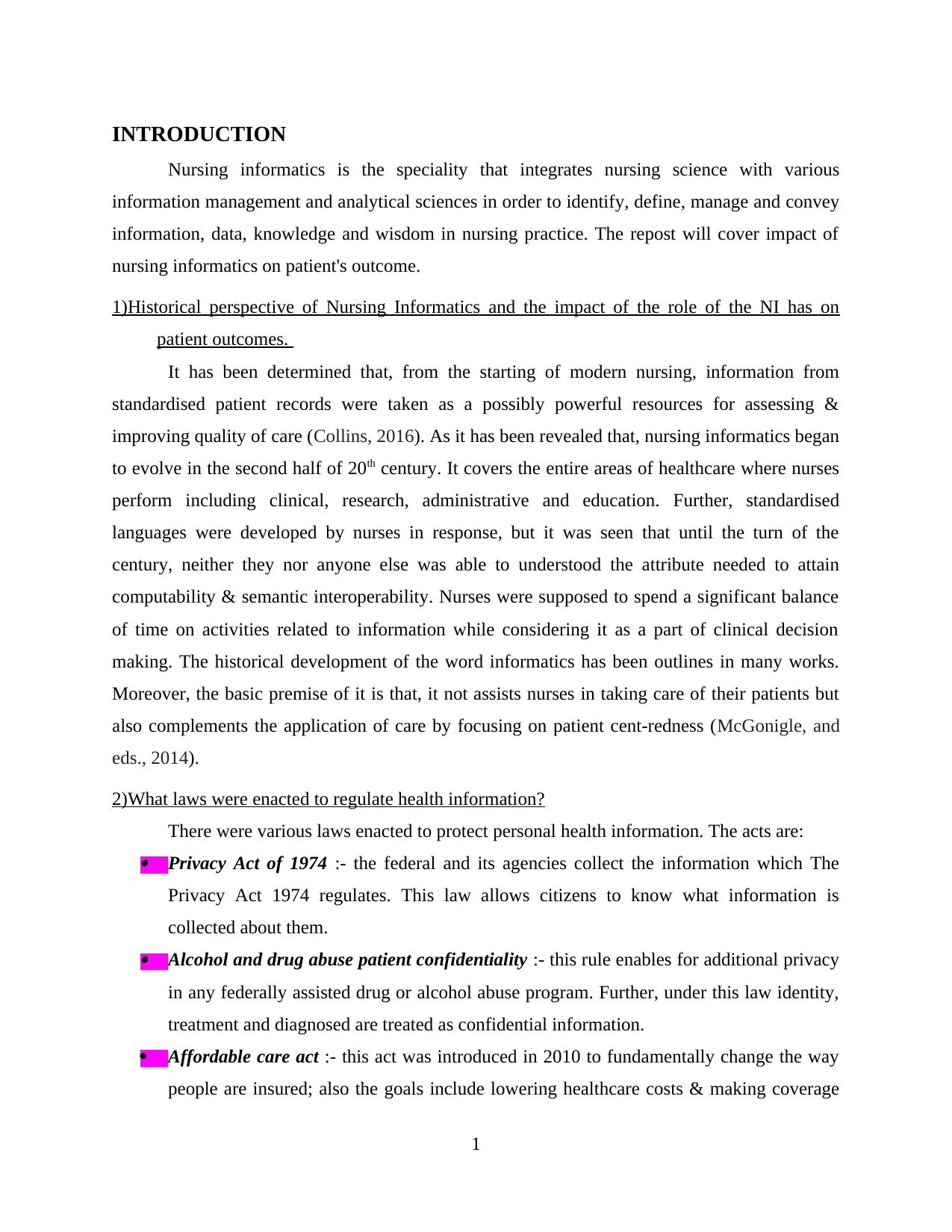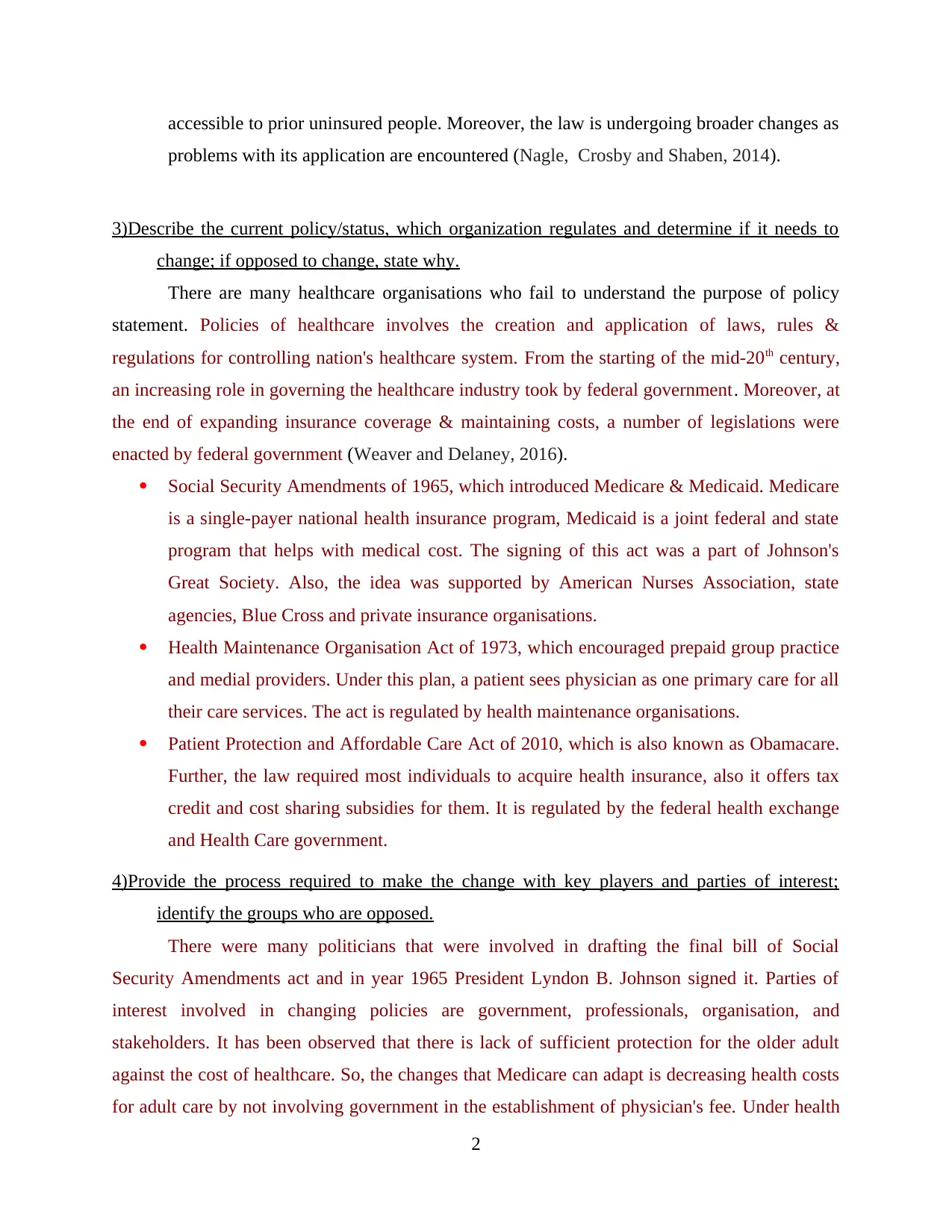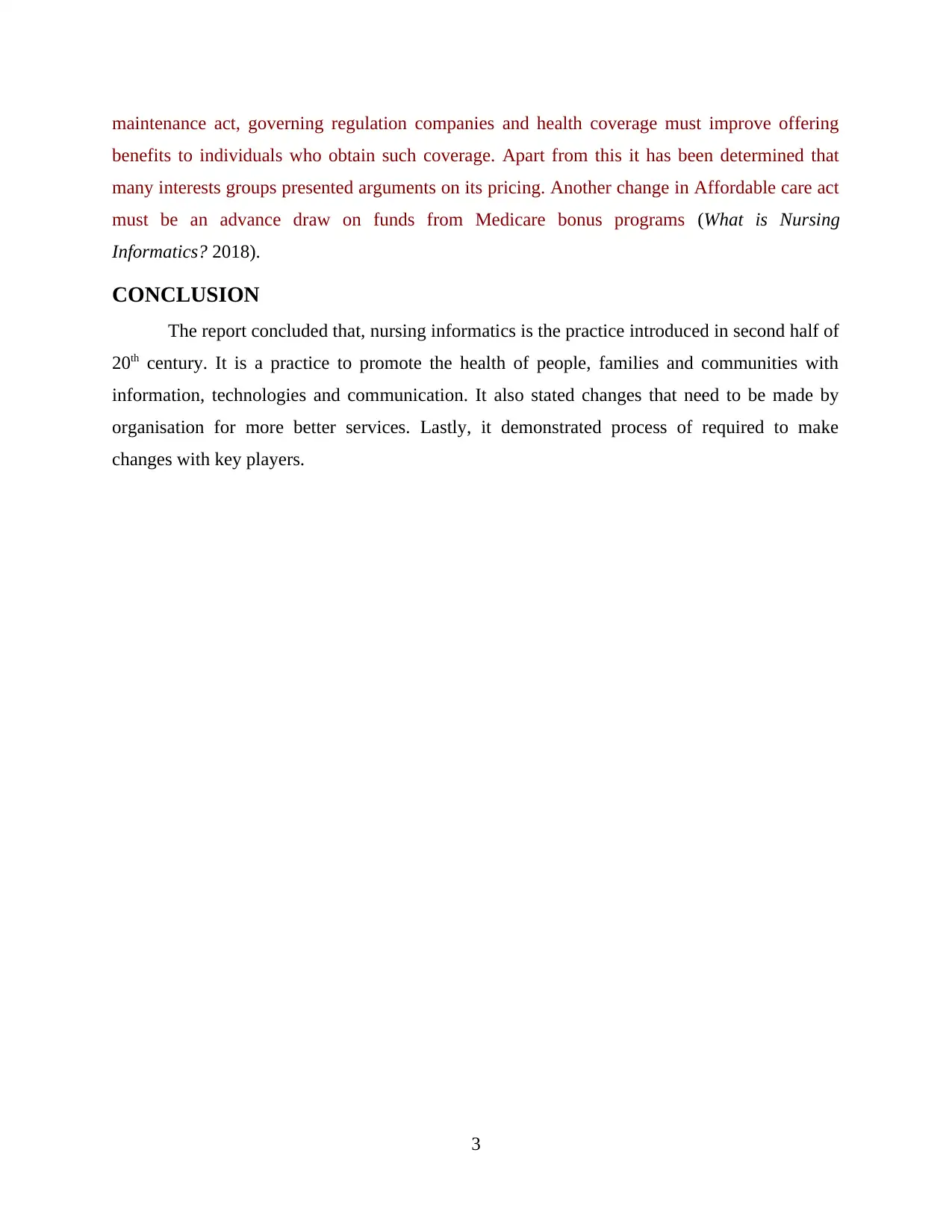Nursing Informatics' Influence on Patient Outcomes: A Detailed Report
VerifiedAdded on 2020/10/23
|7
|1233
|63
Report
AI Summary
This report delves into the significant impact of nursing informatics on patient outcomes, exploring its historical evolution and integration with nursing science. It examines the role of nursing informatics in managing and conveying crucial data and information within healthcare settings, ultimately aiming to enhance patient care. The report further analyzes key laws enacted to regulate health information, such as the Privacy Act of 1974 and the Affordable Care Act, while also assessing current healthcare policies and the regulatory bodies overseeing them. It also discusses the processes involved in policy changes, identifying the key players, interested parties, and opposing groups. The conclusion emphasizes the importance of nursing informatics in promoting health through the effective use of information, technology, and communication, and suggests necessary organizational adjustments for improved services.

Impact the role of Nurse
Informatics has on patient's
outcome
Informatics has on patient's
outcome
Paraphrase This Document
Need a fresh take? Get an instant paraphrase of this document with our AI Paraphraser

Table of Contents
INTRODUCTION...........................................................................................................................1
1)Historical perspective of Nursing Informatics and the impact of the role of the NI has on
patient outcomes. ...................................................................................................................1
2)What laws were enacted to regulate health information?...................................................1
3)Describe the current policy/status, which organization regulates and determine if it needs to
change; if opposed to change, state why................................................................................2
4)Provide the process required to make the change with key players and parties of interest;
identify the groups who are opposed......................................................................................2
CONCLUSION................................................................................................................................3
REFERENCES................................................................................................................................4
INTRODUCTION...........................................................................................................................1
1)Historical perspective of Nursing Informatics and the impact of the role of the NI has on
patient outcomes. ...................................................................................................................1
2)What laws were enacted to regulate health information?...................................................1
3)Describe the current policy/status, which organization regulates and determine if it needs to
change; if opposed to change, state why................................................................................2
4)Provide the process required to make the change with key players and parties of interest;
identify the groups who are opposed......................................................................................2
CONCLUSION................................................................................................................................3
REFERENCES................................................................................................................................4

⊘ This is a preview!⊘
Do you want full access?
Subscribe today to unlock all pages.

Trusted by 1+ million students worldwide

INTRODUCTION
Nursing informatics is the speciality that integrates nursing science with various
information management and analytical sciences in order to identify, define, manage and convey
information, data, knowledge and wisdom in nursing practice. The repost will cover impact of
nursing informatics on patient's outcome.
1)Historical perspective of Nursing Informatics and the impact of the role of the NI has on
patient outcomes.
It has been determined that, from the starting of modern nursing, information from
standardised patient records were taken as a possibly powerful resources for assessing &
improving quality of care (Collins, 2016). As it has been revealed that, nursing informatics began
to evolve in the second half of 20th century. It covers the entire areas of healthcare where nurses
perform including clinical, research, administrative and education. Further, standardised
languages were developed by nurses in response, but it was seen that until the turn of the
century, neither they nor anyone else was able to understood the attribute needed to attain
computability & semantic interoperability. Nurses were supposed to spend a significant balance
of time on activities related to information while considering it as a part of clinical decision
making. The historical development of the word informatics has been outlines in many works.
Moreover, the basic premise of it is that, it not assists nurses in taking care of their patients but
also complements the application of care by focusing on patient cent-redness (McGonigle, and
eds., 2014).
2)What laws were enacted to regulate health information?
There were various laws enacted to protect personal health information. The acts are: Privacy Act of 1974 :- the federal and its agencies collect the information which The
Privacy Act 1974 regulates. This law allows citizens to know what information is
collected about them. Alcohol and drug abuse patient confidentiality :- this rule enables for additional privacy
in any federally assisted drug or alcohol abuse program. Further, under this law identity,
treatment and diagnosed are treated as confidential information.
Affordable care act :- this act was introduced in 2010 to fundamentally change the way
people are insured; also the goals include lowering healthcare costs & making coverage
1
Nursing informatics is the speciality that integrates nursing science with various
information management and analytical sciences in order to identify, define, manage and convey
information, data, knowledge and wisdom in nursing practice. The repost will cover impact of
nursing informatics on patient's outcome.
1)Historical perspective of Nursing Informatics and the impact of the role of the NI has on
patient outcomes.
It has been determined that, from the starting of modern nursing, information from
standardised patient records were taken as a possibly powerful resources for assessing &
improving quality of care (Collins, 2016). As it has been revealed that, nursing informatics began
to evolve in the second half of 20th century. It covers the entire areas of healthcare where nurses
perform including clinical, research, administrative and education. Further, standardised
languages were developed by nurses in response, but it was seen that until the turn of the
century, neither they nor anyone else was able to understood the attribute needed to attain
computability & semantic interoperability. Nurses were supposed to spend a significant balance
of time on activities related to information while considering it as a part of clinical decision
making. The historical development of the word informatics has been outlines in many works.
Moreover, the basic premise of it is that, it not assists nurses in taking care of their patients but
also complements the application of care by focusing on patient cent-redness (McGonigle, and
eds., 2014).
2)What laws were enacted to regulate health information?
There were various laws enacted to protect personal health information. The acts are: Privacy Act of 1974 :- the federal and its agencies collect the information which The
Privacy Act 1974 regulates. This law allows citizens to know what information is
collected about them. Alcohol and drug abuse patient confidentiality :- this rule enables for additional privacy
in any federally assisted drug or alcohol abuse program. Further, under this law identity,
treatment and diagnosed are treated as confidential information.
Affordable care act :- this act was introduced in 2010 to fundamentally change the way
people are insured; also the goals include lowering healthcare costs & making coverage
1
Paraphrase This Document
Need a fresh take? Get an instant paraphrase of this document with our AI Paraphraser

accessible to prior uninsured people. Moreover, the law is undergoing broader changes as
problems with its application are encountered (Nagle, Crosby and Shaben, 2014).
3)Describe the current policy/status, which organization regulates and determine if it needs to
change; if opposed to change, state why.
There are many healthcare organisations who fail to understand the purpose of policy
statement. Policies of healthcare involves the creation and application of laws, rules &
regulations for controlling nation's healthcare system. From the starting of the mid-20th century,
an increasing role in governing the healthcare industry took by federal government. Moreover, at
the end of expanding insurance coverage & maintaining costs, a number of legislations were
enacted by federal government (Weaver and Delaney, 2016).
Social Security Amendments of 1965, which introduced Medicare & Medicaid. Medicare
is a single-payer national health insurance program, Medicaid is a joint federal and state
program that helps with medical cost. The signing of this act was a part of Johnson's
Great Society. Also, the idea was supported by American Nurses Association, state
agencies, Blue Cross and private insurance organisations.
Health Maintenance Organisation Act of 1973, which encouraged prepaid group practice
and medial providers. Under this plan, a patient sees physician as one primary care for all
their care services. The act is regulated by health maintenance organisations.
Patient Protection and Affordable Care Act of 2010, which is also known as Obamacare.
Further, the law required most individuals to acquire health insurance, also it offers tax
credit and cost sharing subsidies for them. It is regulated by the federal health exchange
and Health Care government.
4)Provide the process required to make the change with key players and parties of interest;
identify the groups who are opposed.
There were many politicians that were involved in drafting the final bill of Social
Security Amendments act and in year 1965 President Lyndon B. Johnson signed it. Parties of
interest involved in changing policies are government, professionals, organisation, and
stakeholders. It has been observed that there is lack of sufficient protection for the older adult
against the cost of healthcare. So, the changes that Medicare can adapt is decreasing health costs
for adult care by not involving government in the establishment of physician's fee. Under health
2
problems with its application are encountered (Nagle, Crosby and Shaben, 2014).
3)Describe the current policy/status, which organization regulates and determine if it needs to
change; if opposed to change, state why.
There are many healthcare organisations who fail to understand the purpose of policy
statement. Policies of healthcare involves the creation and application of laws, rules &
regulations for controlling nation's healthcare system. From the starting of the mid-20th century,
an increasing role in governing the healthcare industry took by federal government. Moreover, at
the end of expanding insurance coverage & maintaining costs, a number of legislations were
enacted by federal government (Weaver and Delaney, 2016).
Social Security Amendments of 1965, which introduced Medicare & Medicaid. Medicare
is a single-payer national health insurance program, Medicaid is a joint federal and state
program that helps with medical cost. The signing of this act was a part of Johnson's
Great Society. Also, the idea was supported by American Nurses Association, state
agencies, Blue Cross and private insurance organisations.
Health Maintenance Organisation Act of 1973, which encouraged prepaid group practice
and medial providers. Under this plan, a patient sees physician as one primary care for all
their care services. The act is regulated by health maintenance organisations.
Patient Protection and Affordable Care Act of 2010, which is also known as Obamacare.
Further, the law required most individuals to acquire health insurance, also it offers tax
credit and cost sharing subsidies for them. It is regulated by the federal health exchange
and Health Care government.
4)Provide the process required to make the change with key players and parties of interest;
identify the groups who are opposed.
There were many politicians that were involved in drafting the final bill of Social
Security Amendments act and in year 1965 President Lyndon B. Johnson signed it. Parties of
interest involved in changing policies are government, professionals, organisation, and
stakeholders. It has been observed that there is lack of sufficient protection for the older adult
against the cost of healthcare. So, the changes that Medicare can adapt is decreasing health costs
for adult care by not involving government in the establishment of physician's fee. Under health
2

maintenance act, governing regulation companies and health coverage must improve offering
benefits to individuals who obtain such coverage. Apart from this it has been determined that
many interests groups presented arguments on its pricing. Another change in Affordable care act
must be an advance draw on funds from Medicare bonus programs (What is Nursing
Informatics? 2018).
CONCLUSION
The report concluded that, nursing informatics is the practice introduced in second half of
20th century. It is a practice to promote the health of people, families and communities with
information, technologies and communication. It also stated changes that need to be made by
organisation for more better services. Lastly, it demonstrated process of required to make
changes with key players.
3
benefits to individuals who obtain such coverage. Apart from this it has been determined that
many interests groups presented arguments on its pricing. Another change in Affordable care act
must be an advance draw on funds from Medicare bonus programs (What is Nursing
Informatics? 2018).
CONCLUSION
The report concluded that, nursing informatics is the practice introduced in second half of
20th century. It is a practice to promote the health of people, families and communities with
information, technologies and communication. It also stated changes that need to be made by
organisation for more better services. Lastly, it demonstrated process of required to make
changes with key players.
3
⊘ This is a preview!⊘
Do you want full access?
Subscribe today to unlock all pages.

Trusted by 1+ million students worldwide

REFERENCES
Books & Journals
Collins, S., 2016. Nursing Informatics Competencies: Psychometric Validation, Dissemination,
and Maintenance of Self-Assessment Tool for Nurse Leaders. In Nursing Informatics (pp.
710-712).
McGonigle, D. and Mastrian, K. eds., 2014. Nursing informatics and the foundation of
knowledge. Jones & Bartlett Publishers.
Nagle, L. M., Crosby, K. and Shaben, T., 2014, July. Developing entry-to-practice nursing
informatics competencies for registered nurses. In Nursing Informatics (pp. 356-363).
Weaver, C. A. and Delaney, C. W., 2016. Nursing and Nursing Informatics: Current Context to
Preferred Future. In Nursing and Informatics for the 21st Century (pp. 601-620). HIMSS
Publishing.
Online
What is Nursing Informatics? 2018. [Online]. Available on:
<https://www.herzing.edu/blog/what-nursing-informatics>
4
Books & Journals
Collins, S., 2016. Nursing Informatics Competencies: Psychometric Validation, Dissemination,
and Maintenance of Self-Assessment Tool for Nurse Leaders. In Nursing Informatics (pp.
710-712).
McGonigle, D. and Mastrian, K. eds., 2014. Nursing informatics and the foundation of
knowledge. Jones & Bartlett Publishers.
Nagle, L. M., Crosby, K. and Shaben, T., 2014, July. Developing entry-to-practice nursing
informatics competencies for registered nurses. In Nursing Informatics (pp. 356-363).
Weaver, C. A. and Delaney, C. W., 2016. Nursing and Nursing Informatics: Current Context to
Preferred Future. In Nursing and Informatics for the 21st Century (pp. 601-620). HIMSS
Publishing.
Online
What is Nursing Informatics? 2018. [Online]. Available on:
<https://www.herzing.edu/blog/what-nursing-informatics>
4
1 out of 7
Related Documents
Your All-in-One AI-Powered Toolkit for Academic Success.
+13062052269
info@desklib.com
Available 24*7 on WhatsApp / Email
![[object Object]](/_next/static/media/star-bottom.7253800d.svg)
Unlock your academic potential
Copyright © 2020–2025 A2Z Services. All Rights Reserved. Developed and managed by ZUCOL.





